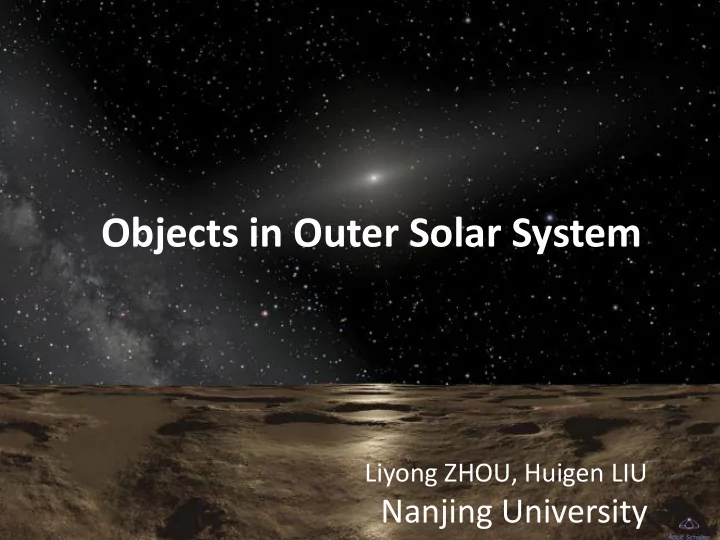

Objects in Outer Solar System Liyong ZHOU, Huigen LIU Nanjing University
Outer Solar System
Trans-Neptunian Objects Orbits of TNOs (semi-major axis vs . inclination) ➢ TNOs, as the remnants from the early stage of the Solar system, their masses, sizes, shapes, material composition and their distribution in space keep important information about the formation and evolution of the Solar system. ➢ The total mass/number of TNOs is about 20-200 times of the main belt asteroids. The number of TNOs with diameters greater than 100km is estimated to be over 100,000. ➢ Up to now, about 2,000 of TNOs have been detected. A large number of TNOs are still unseen.
Trans-Neptunian Objects ➢ About ¼ TNOs are found on orbits with Nontrivial distribution: inclination higher than 20deg. ➢ Classical TNOs ➢ In recent years, a new group of TNOs are ➢ Resonant TNOs recognized: Detached TNOs (with very large ➢ Scattered TNOs (Centaurs) perihelion distance), implying the existence of a massive object far away in the solar system. ➢ Planet Nine???
Trans-Neptunian Objects ➢ Various Models have been proposed to explain their spatial distribution and orbits characteristics. Planet migration, stellar encounter, scattering planet embryo, ….. Levison et al. 2008 (Nice model) Nesvorny et al. 2015 (slow migration model)
Trans-Neptunian Objects Color-inclination relation : The correlation is strong (ρ = – 0.7) and highly significant (>8σ) in the range 0 ° --34 ° . The optical colors are independent of inclination below ≈12 ° . Objects with inclinations >=12 ° show bluish colors, which are either weakly correlated with inclination or simply homogeneously blue, whereas objects with inclinations less than 12 ° are homogeneously red. N.Peixinho et al, 2008
Trans-Neptunian Objects Models have to be modified to produce such dependence on inclination. Are there any other dependence?
Observations of TNOs ➢ Neptune Trojans (NTs) The total number and mass of Neptune Trojans are also believed to be above the main belt asteroids. They have peculiar orbits. Observed NTs, many of them have high inclinations ➢ The basic data, like the light curve, spectral and even photometry data of TNOs and NTs are still quite rare. Color indices of limited number of TNOs (red) and NTs(blue)
Observations of TNOs ➢ The most productive observation up to now, the Deep Ecliptic Survey (completed in 2005), found 662 TNOs in 550deg 2 near the ecliptic ( β ± 6.5˚). Number of TNOs found (black) ➢ Other surveys: Pan-STARRS (Diameter 1.8m X 2, FOV~3deg 2 , <24.5 m , δ <-47.5 ˚ ). Expect to find 20,000 TNOs. Dark Energy Survey (Diameter 4m, FOV~5deg 2 , <24 m , 5000deg 2 around the south galactic cap). Reported 32 TNOs discoveries in an area of 27deg 2 (-15 ˚ > β >-45 ˚ ). 32 TNOs found by DES (red dots) CFHT (Diameter 3.6m, FOV~1deg 2 , r<24.5 m ) Outer Solar System Origins Survey , along the ecliptic, 84deg 2 /year, expect 3-4 TNOs/deg 2 , measure precisely their orbits. LSST (Diameter 8.4m, FOV~9.6deg 2 ). Expect to observe 40,000 TNOs in 10 years. Hundreds of LSST survey. Color indicates the times photometry data for each target. of observation.
Possible Observation in CSS-OS ➢ Discovery and Orbit Determination of TNOs and NTs ➢ Discovery - Compared to asteroids (~700,000), TNOs and NTs are still “too few”. ➢ Improvement – TNOs generally have poor accuracy of orbital elements. The apparent motion is less than 4” /h at 40AU, ~70s/pixel, magnitude 25 m , three exposures, interval ~10d. ~100TNOs/deg 2 near the ecliptic plane (<25 m ) ➢ Photometry and Spectroscopy of TNOs and NTs ➢ Spectroscopy – Information about the surface, thus origin and evolution. ➢ Photometry – Size, shape, detecting binary systems, ring systems. Multi-band Photometry, Spectroscopy, to the limit magnitude Light curve: continuous observation of hours ➢ Planet Nine Detached TNOs implies the existence of Planet Nine m 9 : 10 Earth masses (Batygin & Brown 2016) a 9 : 400-700 AU q 9 : 250 AU
Possible Observation in CSS-OS Direct Detection of Planet Nine V mag : 22-28 Big space telescopes is preferred Proper motion: <0.2 arc sec/day Possible regions for Planet Nine (+ Cassini data ) ➢ Green regions : possible ➢ Red regions: impossible ➢ White regions: uncertain Total : 180 x 14 ~ 2500 sq. deg. wide field telescope More constraints from GAIA. Observational strategy: sky survey with an interval Fienga et al. 2016 10 day to verify the motion of Planet Nine.
Possible Observation in CSS-OS Indirect Detection of Planet Nine – Highly inclined or retrograde TNOs. Niku: a = 36 au, e = 0.3, i = 110 ° 2008 KV42: a = 41 au, e = 0.5, i = 103 ° 2016 NM56: a = 74 au, e = 0.9, i = 144 ° (Chen et el. 2016, ApJL) Are they really rare?
Transit follow-ups for TESS Requiements of RV follow-ups Not enough telescopes with high precision spectroscopy TTV method is a good way to confirm small planet pairs near MMR; Photometry precision <= 1000 ppm (Neptune-sized planets)
Planet detection via Micro lensing Possible to detect Earth-like planets near HZ; OGLE-2005-BLG-390 b: 5.5 Earth Mass around 0.22 Solar Mass star; Semi-major axis~ 2-4.1 AU Data Cadence Requirements: < 3 min; last > 60 min;
Recommend
More recommend